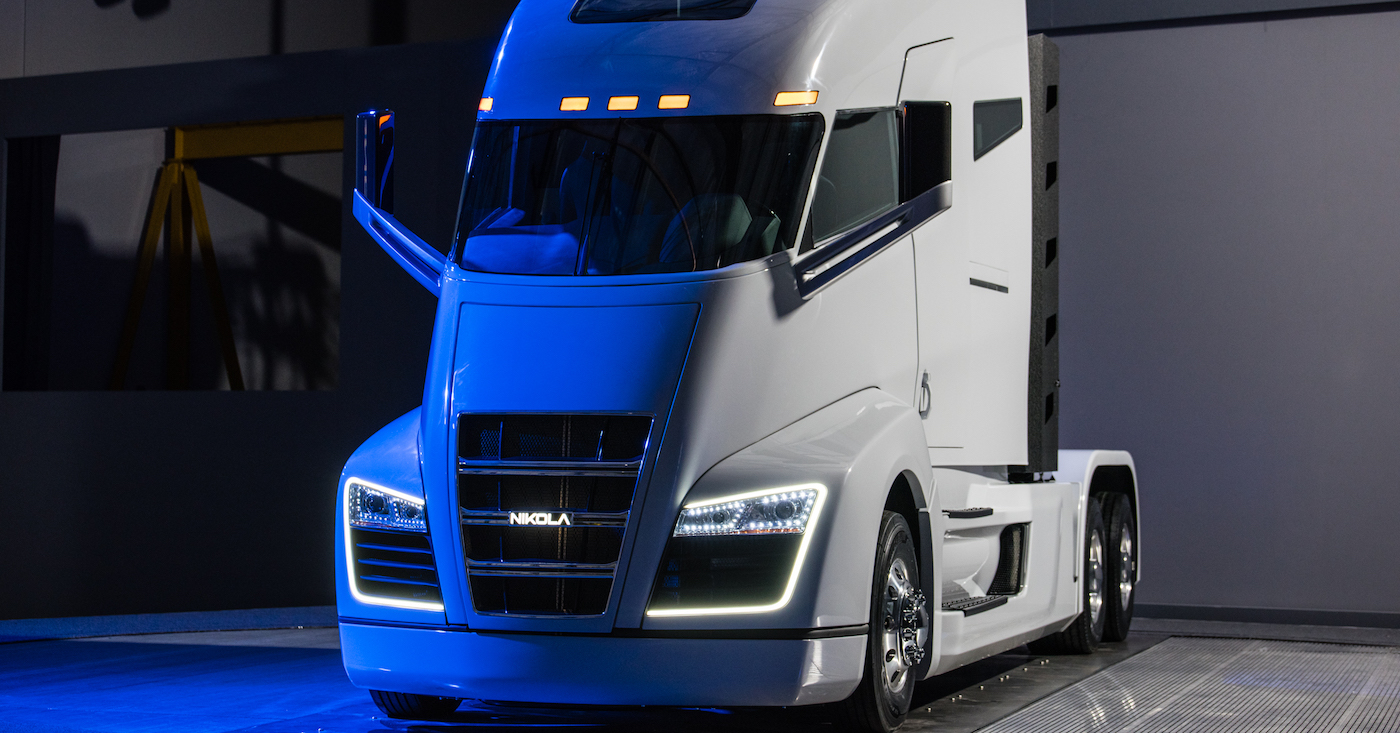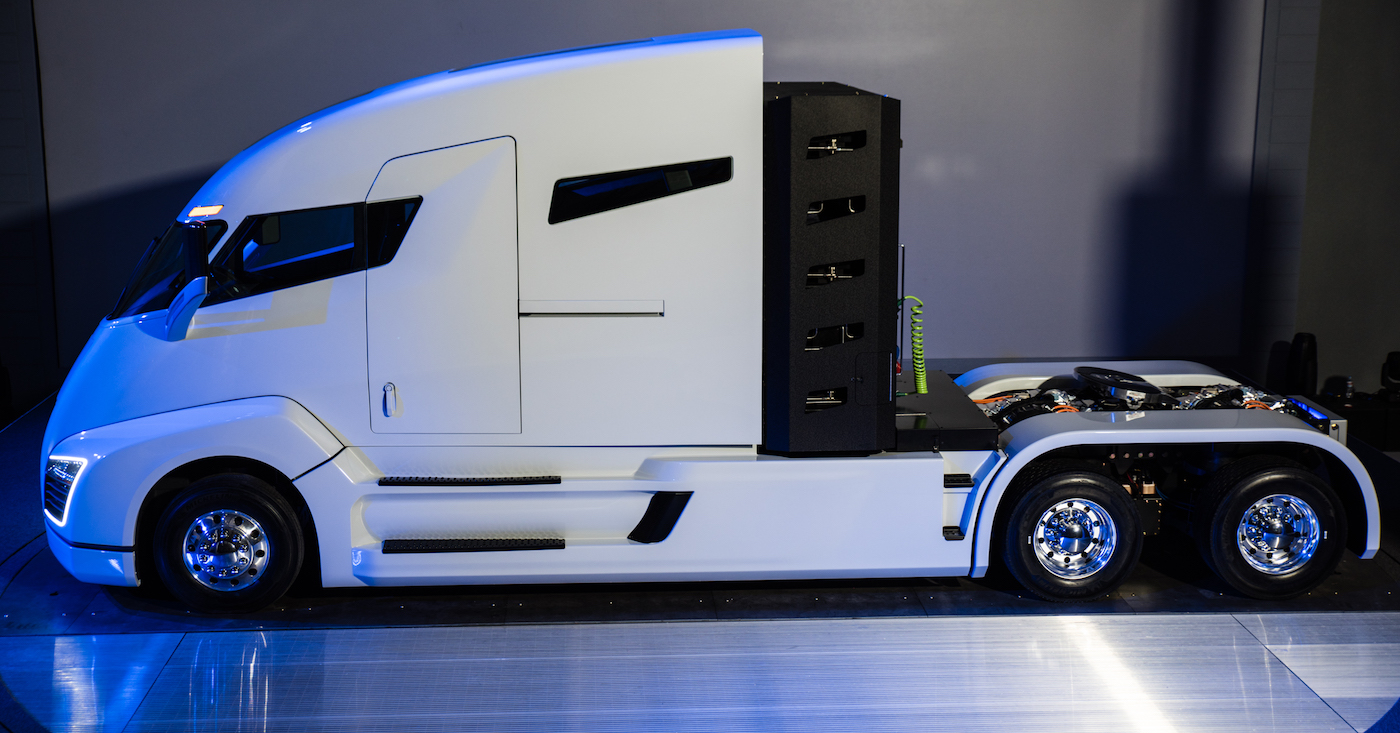News
Nikola Motor unveils 1,000 HP hydrogen-electric truck with 1,200 mi. range

Nikola Motor Company unveiled its zero emissions Class 8 truck at company headquarters this week. Dubbed the Nikola One, the once all-electric prototype now hydrogen powered, boasts an incredible 1,200 miles of range and will be stiff competition for Tesla’s planned entry into the long haul trucking segment with its all-electric Tesla Semi.
Nikola One is sleek and futuristic. Because it has no diesel engine, the cab can be pushed forward as far as possible to give the driver a panoramic view of the road ahead. Individual electric motors for each of its six wheels provides an incredible 1,000 horsepower and 2,000 lb-ft of torque. Both numbers are considerably higher than for a typical tractor.
Power comes from a 320 kWh battery developed by the company. “Our battery engineers have made major advances in storage and cooling,” said Nikola founder and CEO Trevor Milton. “We believe our lithium battery packs are more energy dense and weigh less than any available vehicle production pack per kWh.”
The company had previously designed Nikola One as an electric truck that would have a range extender via a turbine powered by natural gas. But at the reveal, the company announced the turbine has been replaced by a hydrogen fuel cell that will keep the battery charged and provide a range between 800 to 1,200 miles.
The prototype on display this week is technological marvel. An array of sensors and cameras permit the driver to have a full 360º view around the entire rig at all times, eliminating blind spots all together. Inside the cab there is room for a one or two full size beds, a refrigerator/freezer, a 40″ curved 4K TV with Apple TV, as well as Wi-Fi and 4G LTE connectivity. Comfort and convenience for the driver will be unparalleled.
The company says it is evaluating a number of locations for its factory. “Nikola will build a world-class advanced manufacturing facility which will create thousands of new jobs,” says Trevor Milton. He claims the factory will be able to build 50,000 trucks a year by 2020.
So far, one might be forgiven for thinking the Nikola One is mostly vaporware except for one thing. The company has struck a deal with Ryder Systems, which has agreed to be Nikola’s exclusive nationwide distribution and maintenance provider. Ryder has a network of over 800 service locations in North America today.
“We are extremely excited to finally show off the Nikola One to the public for the first time,” said Milton. “There are many out there that wondered if we would deliver, but today we proudly show off the most advanced semi-truck ever built. We couldn’t be more thrilled to have one of the best brands in America, Ryder, as our trusted partner providing nationwide sales, service and warranty for Nikola Motor Company.”
The financial plan for the company calls for leasing the trucks for 72 months at rates of between $5,000 and $7,000 a month. The lease fee will cover all scheduled maintenance at a Ryder facility and the cost of hydrogen fuel. Talking a page from the Tesla playbook, Nikola is accepting reservations for its battery/fuel cell Class 8 truck. It says it has received billions of dollars worth of deposits which cost $1,500 and are fully refundable.
Meanwhile, Elon Musk has let it be known that he also has his eye on the heavy truck market. We can be sure his vision for a Tesla Semi won’t involve any onboard fossil fueled range extender engines or what he dismissively calls “fool cells.”
The Coast of Hydrogen
Nikola says it intends to develop a network of 350 hydrogen fueling stations across North America for its trucks, beginning in 2018. It would be similar to the Supercharger network Tesla has been building to support long distance travel for its fleet of electric cars. But here’s the rub.
Hydrogen refueling stations cost $2 million or more to construct. It is estimated that a typical Tesla Supercharger location costs about one tenth as much to build. Exactly who will be paying for the hydrogen refueling system is unclear. And there are other issues with using hydrogen. Yes, the waste products of a fuel cell are water vapor and heat. But getting the hydrogen requires tremendous amounts of energy.
In the US, most hydrogen is derived from natural gas. Take the process back a step or two and that natural gas is often the result of fracking, a process that at the very least is controversial and at worst results in heavy pollution of the land and groundwater in the vicinity. Whether the Nikola One can accurately be called “zero emissions” is a matter for debate.

Elon Musk
Elon Musk’s X will start using a Tesla-like software update strategy
The initiative seems designed to accelerate updates to the social media platform, while maintaining maximum transparency.

Elon Musk’s social media platform X will adopt a Tesla-esque approach to software updates for its algorithm.
The initiative seems designed to accelerate updates to the social media platform, while maintaining maximum transparency.
X’s updates to its updates
As per Musk in a post on X, the social media company will be making a new algorithm to determine what organic and advertising posts are recommended to users. These updates would then be repeated every four weeks.
“We will make the new 𝕏 algorithm, including all code used to determine what organic and advertising posts are recommended to users, open source in 7 days. This will be repeated every 4 weeks, with comprehensive developer notes, to help you understand what changed,” Musk wrote in his post.
The initiative somewhat mirrors Tesla’s over-the-air update model, where vehicle software is regularly refined and pushed to users with detailed release notes. This should allow users to better understand the details of X’s every update and foster a healthy feedback loop for the social media platform.
xAI and X
X, formerly Twitter, has been acquired by Elon Musk’s artificial intelligence startup, xAI last year. Since then, xAI has seen a rapid rise in valuation. Following the company’s the company’s upsized $20 billion Series E funding round, estimates now suggest that xAI is worth tens about $230 to $235 billion. That’s several times larger than Tesla when Elon Musk received his controversial 2018 CEO Performance Award.
As per xAI, the Series E funding round attracted a diverse group of investors, including Valor Equity Partners, Stepstone Group, Fidelity Management & Research Company, Qatar Investment Authority, MGX, and Baron Capital Group, among others. Strategic partners NVIDIA and Cisco Investments also continued support for building the world’s largest GPU clusters.
News
Tesla FSD Supervised wins MotorTrend’s Best Driver Assistance Award
The decision marks a notable reversal for the publication from prior years, with judges citing major real-world improvements that pushed Tesla’s latest FSD software ahead of every competing ADAS system.

Tesla’s Full Self-Driving (Supervised) system has been named the best driver-assistance technology on the market, earning top honors at the 2026 MotorTrend Best Tech Awards.
The decision marks a notable reversal for the publication from prior years, with judges citing major real-world improvements that pushed Tesla’s latest FSD software ahead of every competing ADAS system. And it wasn’t even close.
MotorTrend reverses course
MotorTrend awarded Tesla FSD (Supervised) its 2026 Best Tech Driver Assistance title after extensive testing of the latest v14 software. The publication acknowledged that it had previously criticized earlier versions of FSD for erratic behavior and near-miss incidents, ultimately favoring rivals such as GM’s Super Cruise in earlier evaluations.
According to MotorTrend, the newest iteration of FSD resolved many of those shortcomings. Testers said v14 showed far smoother behavior in complex urban scenarios, including unprotected left turns, traffic circles, emergency vehicles, and dense city streets. While the system still requires constant driver supervision, judges concluded that no other advanced driver-assistance system currently matches its breadth of capability.
Unlike rival systems that rely on combinations of cameras, radar, lidar, and mapped highways, Tesla’s FSD operates using a camera-only approach and is capable of driving on city streets, rural roads, and freeways. MotorTrend stated that pure utility, the ability to handle nearly all road types, ultimately separated FSD from competitors like Ford BlueCruise, GM Super Cruise, and BMW’s Highway Assistant.
High cost and high capability
MotorTrend also addressed FSD’s pricing, which remains significantly higher than rival systems. Tesla currently charges $8,000 for a one-time purchase or $99 per month for a subscription, compared with far lower upfront and subscription costs from other automakers. The publication noted that the premium is justified given FSD’s unmatched scope and continuous software evolution.
Safety remained a central focus of the evaluation. While testers reported collision-free operation over thousands of miles, they noted ongoing concerns around FSD’s configurable driving modes, including options that allow aggressive driving and speeds beyond posted limits. MotorTrend emphasized that, like all Level 2 systems, FSD still depends on a fully attentive human driver at all times.
Despite those caveats, the publication concluded that Tesla’s rapid software progress fundamentally reshaped the competitive landscape. For drivers seeking the most capable hands-on driver-assistance system available today, MotorTrend concluded Tesla FSD (Supervised) now stands alone at the top.
News
Elon Musk’s Grokipedia surges to 5.6M articles, almost 79% of English Wikipedia
The explosive growth marks a major milestone for the AI-powered online encyclopedia, which was launched by Elon Musk’s xAI just months ago.

Elon Musk’s Grokipedia has grown to an impressive 5,615,201 articles as of today, closing in on 79% of the English Wikipedia’s current total of 7,119,376 articles.
The explosive growth marks a major milestone for the AI-powered online encyclopedia, which was launched by Elon Musk’s xAI just months ago. Needless to say, it would only be a matter of time before Grokipedia exceeds English Wikipedia in sheer volume.
Grokipedia’s rapid growth
xAI’s vision for Grokipedia emphasizes neutrality, while Grok’s reasoning capabilities allow for fast drafting and fact-checking. When Elon Musk announced the initiative in late September 2025, he noted that Grokipedia would be an improvement to Wikipedia because it would be designed to avoid bias.
At the time, Musk noted that Grokipedia “is a necessary step towards the xAI goal of understanding the Universe.”
Grokipedia was launched in late October, and while xAI was careful to list it only as Version 0.1 at the time, the online encyclopedia immediately earned praise. Wikipedia co-founder Larry Sanger highlighted the project’s innovative approach, noting how it leverages AI to fill knowledge gaps and enable rapid updates. Netizens also observed how Grokipedia tends to present articles in a more objective manner compared to Wikipedia, which is edited by humans.
Elon Musk’s ambitious plans
With 5,615,201 total articles, Grokipedia has now grown to almost 79% of English Wikipedia’s article base. This is incredibly quick, though Grokipedia remains text-only for now. xAI, for its part, has now updated the online encyclopedia’s iteration to v0.2.
Elon Musk has shared bold ideas for Grokipedia, including sending a record of the entire knowledge base to space as part of xAI’s mission to preserve and expand human understanding. At some point, Musk stated that Grokipedia will be renamed to Encyclopedia Galactica, and it will be sent to the cosmos.
“When Grokipedia is good enough (long way to go), we will change the name to Encyclopedia Galactica. It will be an open source distillation of all knowledge, including audio, images and video. Join xAI to help build the sci-fi version of the Library of Alexandria!” Musk wrote, adding in a later post that “Copies will be etched in stone and sent to the Moon, Mars and beyond. This time, it will not be lost.”










